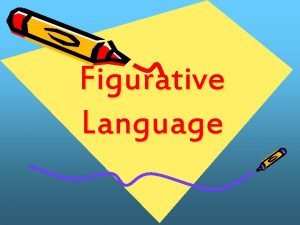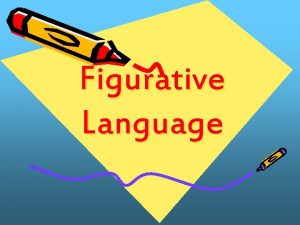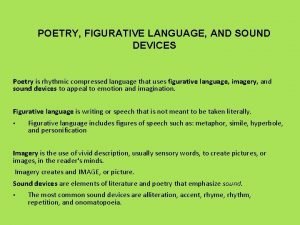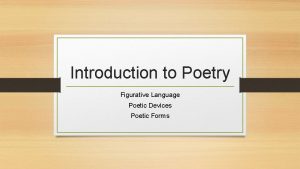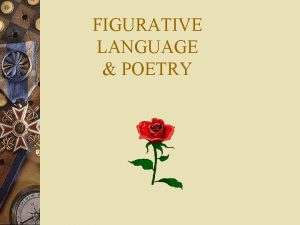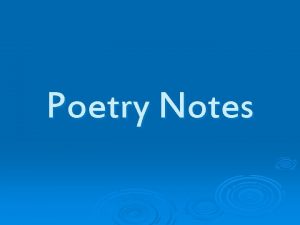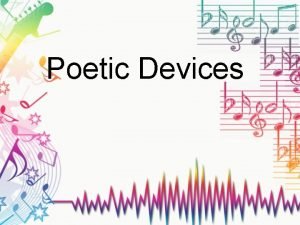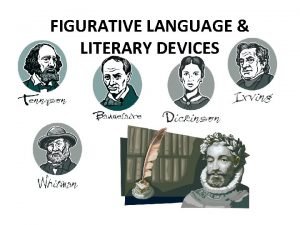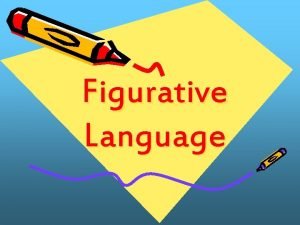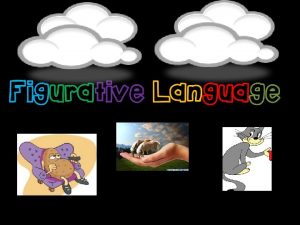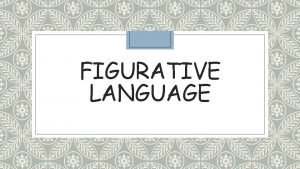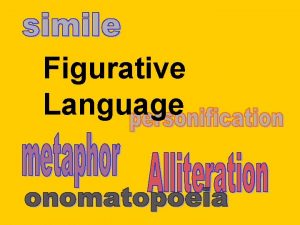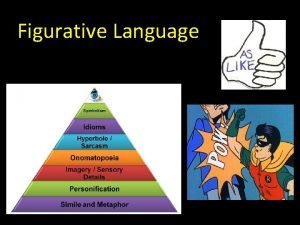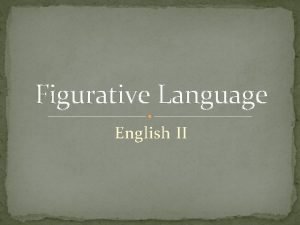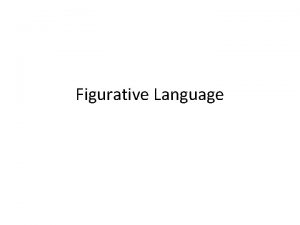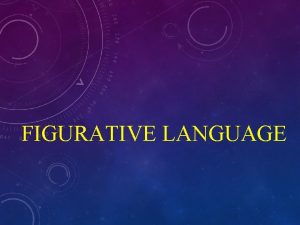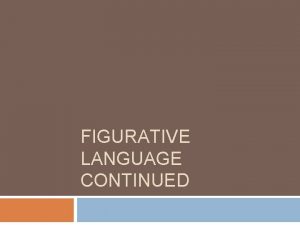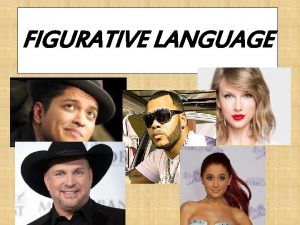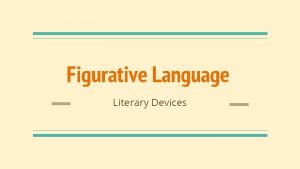Figurative Language and Common Poetry Terms Poetry is












- Slides: 12

Figurative Language and Common Poetry Terms “Poetry is thoughts that breathe, and words that burn. ” ~Thomas Gray “Poetry is when an emotion has found its thought and the thought has found words. ” ~Robert Frost

Sound Devices cont. l Alliteration: The repetition of a sound at the beginning of a series of words l l l “Peter Piper picked a peck of pickled peppers…” “Rain races, ripping like wind. Its restless rage rattles like rocks ripping through the air. ” A fly and a flew up in a flue. Said the fly to the flea, “What shall we do? ” “Let’s fly, ” said the flea. “Let’s flee, ” said the fly. So they fluttered and flew up a flaw in the flue.

Sound Devices l Assonance: The repetition of vowel sounds at any place in a series of words l l l Do you like blue? We viewed the movie about mooing rookies at the school. “Well he seemed so low that I couldn’t say no” – Robert Service (“The Cremation of Sam Mc. Gee, pg. 709)

Sound Devices cont. l Consonance: The repetition of a consonant sound at any place in a series of words. l I dropped the locket in the thick mud. l Eric liked the black book l “And the silken sad uncertain rustling of each purple curtain. ” –Edgar Allen Poe

Sound Device cont. l Onomatopoeia: The use of words whose sound makes one think of its meaning l l l Wham! Bonk! Ding-dong “Cuckoo” Tick-tock “snap, crackle, pop”

Figurative Language l Simile: A comparison of two nouns using the words like or as l l Metaphor: A comparison of two nouns saying that one thing is another l l “My love for you is like a red, red rose” “All the world is a stage” Idiom: An expression that is like a saying. When it’s translated literally, it makes no sense l “Easy as pie”

Figurative Language cont. l Hyperbole: Extreme exaggeration l l The books weigh a ton. I could sleep for a year. I have a million things to do. Personification: When a non-living object has been given qualities of a person l l l The wind whispered through the trees The moon danced on the water “Oreo: Milk’s favorite cookie. ”

Figurative Language cont. l A Symbol: a person, place, thing, or event that stands for itself and for something beyond itself as well. l These show up in poems as Allusions: direct or indirect reference to a familiar figure, place or event from history, literature, mythology. Examples: the American flag symbolizes freedom, liberty, and love for America. A wedding band symbolizes_______. A white flag symbolizes_____. l l l

Figurative Language cont. l l l l Prominent Symbols in Literature The Four Seasons: Spring: birth, rebirth, new beginnings, new life, etc. Summer: the prime of life, youthful, energetic, growing Fall: the decline, the approach of death, getting old Winter: death, the end of life, something comes to an end Day: life, goodness, knowledge, honesty, happiness, energy, purity, positive, light, understanding, clarity Night: death, evil, darkness, mystery, bad, the end, scary, uninformed, unknown

Figurative Language cont. l Prominent Symbols in Literature cont. l The Cycle of Life: l Dawn: new beginning, birth, rebirth Dusk: approach of the end, unknown l l l Paths/Roads: journey, life’s journey, choices, obstacles Bridges: movement form one place to another symbolically Water: gives and takes life, thought to be the source of first life, rebirth Earth: mother, life giving, fertility Gardens: fertility, life giving Rocks/Doors/Weather: obstacles, problems (could be good or bad)

Rhythm l Repetition: The repeating of a word or phrase to add rhythm or to emphasize an idea l “And miles to go before I sleep, And miles to go before I sleep. ” –Robert Frost, “Stopping By Woods on a Snowy Evening” l “The road was a ribbon of moonlight, over the purple moor, And the highwayman came riding- Riding-riding. The highwayman came riding, up to the old inn-door. ” –Alfred Noyes, “The Highwayman”

Form l Stanza: A division in a poem named for the number of lines it contains, such as a couplet (2 lines), triplet (3 lines), quatrain (4 lines), and octave (8 lines) l This is as though the poem is broken up into “paragraphs” l “Gleaming in silver are the hills! Blazing in silver is the sea! And a silvery radiance spills Where the moon drives royally!” –James Stevens, “Washed in Silver”
 Polynomial degrees and terms
Polynomial degrees and terms What are the like terms in the algebraic expression
What are the like terms in the algebraic expression Figurative and literal language examples
Figurative and literal language examples Polly peters positively played ping pong
Polly peters positively played ping pong Figurative language with sounds
Figurative language with sounds Figurative language in introduction to poetry
Figurative language in introduction to poetry Short poems with figurative language
Short poems with figurative language Language
Language Personification in introduction to poetry by billy collins
Personification in introduction to poetry by billy collins Enjambment examples in literature
Enjambment examples in literature There once was an ape in a zoo limerick
There once was an ape in a zoo limerick Literal or figurative
Literal or figurative Figurative language comic
Figurative language comic


